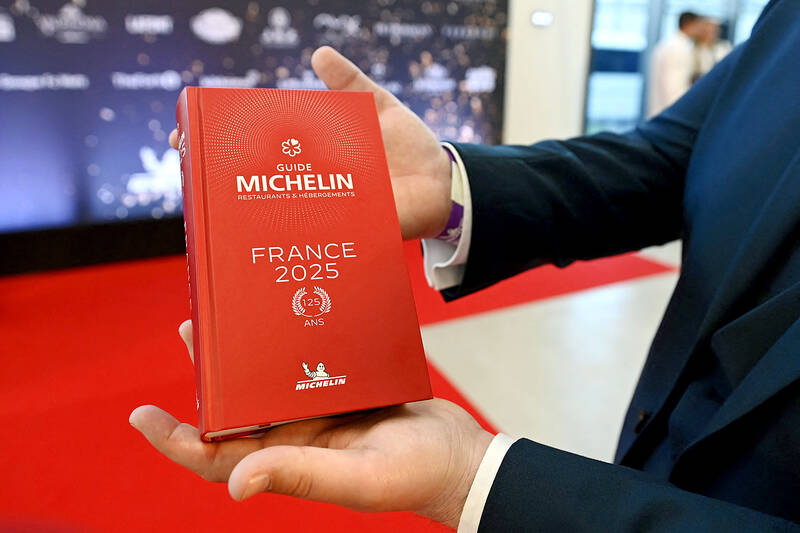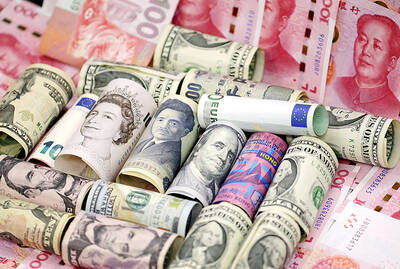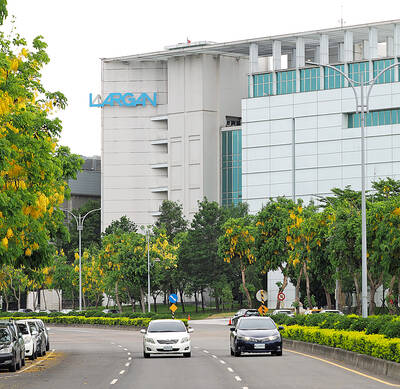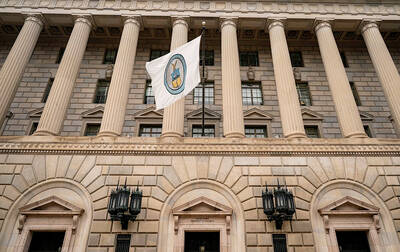France’s famed Michelin Guide, a reference for fine dining for more than a century, is expanding into hotel and wine recommendations as it aims to become a global lifestyle brand.
The offshoot of the French tire-making company has a loyal following among foodies, but faces a battle for attention with other travel guides and review sites such as TripAdvisor, as well as a galaxy of online food influencers.
Staying relevant has led it to look beyond its historic role of sending inspectors anonymously into restaurants and then attributing stars to a handful of high-end eateries. Having gradually increased the number of territories covered by its food guides — 69 at last count — it is now pushing hard into the hotel sector with a new global listing system recommending top-rated resorts and properties.

Photo: AFP
“We have always maintained a strong foothold in the hotel industry,” Michelin Guide international director Gwendal Poullennec on Wednesday night told an awards ceremony attended by hoteliers from across the world in Paris.
Instead of stars, hotels are given “keys,” on a scale of one to three, based on criteria such as service, style and character.
Poullennec also announced on Wednesday that the guide would begin doing reviews for wine, by either building on or rebranding its US-based wine magazine Robert Parker Wine Advocate.
“The Michelin Guide can be regarded today as a global media,” he told reporters earlier.
Funding its costly network of inspectors, who pay their own bills at the company’s expense, has always been an issue.
When Poullennec joined more than 20 years ago, it was loss-making and depended on physical sales of its famous red-colored guides, mostly in western Europe. Nowadays, it has about 9 million unique visitors per month to its Web site and free phone apps, with about half coming from the US. Monetizing those eyeballs has led to online reservation services being offered, with a commission of 10 to 15 percent paid for each booking.
However, the group is also taking money from tourism ministries and public bodies in return for publishing guides, raising questions about its impartiality.
It has such partnerships with dozens of countries and local authorities, most recently Saudi Arabia where the culture ministry has funded a guide that would appear for the first time this year.
The guide faces a balancing act with its tie-ups and partnerships, said University College London School of Management academic Yiting Deng, who has studied the impact of Michelin stars.
“If they work too much with governments, travel agencies and other related parties, there will be this question about credibility and how much their decisions are influenced by other parties,” Deng said.
Poullennec said that the guide keeps its inspectors and commercial teams strictly separate, and only reviews destinations once it judges them to be sufficiently developed.
The focus on hotels is a return to the origins of the guide, which was first published in 1900 by Michelin founders Andre and Edouard Michelin, who wanted to encourage drivers to take to the roads — and burn through their tires.
“When the Michelin Guide was born in 1900, there were more hotel listings than restaurants,” Poullennec said.
Nowadays the industry is awash with competing awards and guides, but none have Michelin’s anonymous inspectors.
Conde Nast, Forbes or Travel + Leisure offer gongs, and there are influential lists such as The World’s 50 Best Hotels, while American Express curates a selection of luxury destinations for its users which is influential among American travelers.
The guide is still a crucial tastemaker, said Alvaro Zarzoso, an academic who studied Michelin stars at the University of Seville in Spain.
In the Internet age, its role “has shifted from solitary gatekeeper to anchor signal inside a network where media exposure and online reviews amplify, rather than replace, its certification,” he said, adding that “expanding into hotels makes strategic sense.”

Taiwan’s foreign exchange reserves hit a record high at the end of last month, surpassing the US$600 billion mark for the first time, the central bank said yesterday. Last month, the country’s foreign exchange reserves rose US$5.51 billion from a month earlier to reach US$602.94 billion due to an increase in returns from the central bank’s portfolio management, the movement of other foreign currencies in the portfolio against the US dollar and the bank’s efforts to smooth the volatility of the New Taiwan dollar. Department of Foreign Exchange Director-General Eugene Tsai (蔡炯民)said a rate cut cycle launched by the US Federal Reserve

Handset camera lens maker Largan Precision Co (大立光) on Sunday reported a 6.71 percent year-on-year decline in revenue for the third quarter, despite revenue last month hitting the highest level in 11 months. Third-quarter revenue was NT$17.68 billion (US$581.2 million), compared with NT$18.95 billion a year earlier, the company said in a statement. The figure was in line with Yuanta Securities Investment Consulting Co’s (元大投顧) forecast of NT$17.9 billion, but missed the market consensus estimate of NT$18.97 billion. The third-quarter revenue was a 51.44 percent increase from NT$11.67 billion in the second quarter, as the quarter is usually the peak

The US government on Wednesday sanctioned more than two dozen companies in China, Turkey and the United Arab Emirates, including offshoots of a US chip firm, accusing the businesses of providing illicit support to Iran’s military or proxies. The US Department of Commerce included two subsidiaries of US-based chip distributor Arrow Electronics Inc (艾睿電子) on its so-called entity list published on the federal register for facilitating purchases by Iran’s proxies of US tech. Arrow spokesman John Hourigan said that the subsidiaries have been operating in full compliance with US export control regulations and his company is discussing with the US Bureau of

Pegatron Corp (和碩), a key assembler of Apple Inc’s iPhones, on Thursday reported a 12.3 percent year-on-year decline in revenue for last quarter to NT$257.86 billion (US$8.44 billion), but it expects revenue to improve in the second half on traditional holiday demand. The fourth quarter is usually the peak season for its communications products, a company official said on condition of anonymity. As Apple released its new iPhone 17 series early last month, sales in the communications segment rose sequentially last month, the official said. Shipments to Apple have been stable and in line with earlier expectations, they said. Pegatron shipped 2.4 million notebook